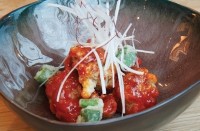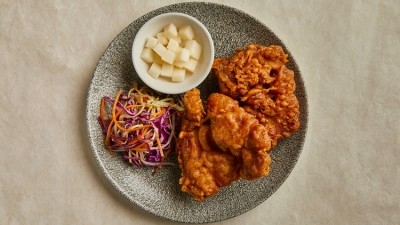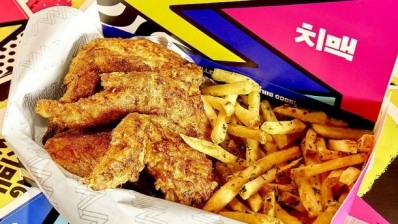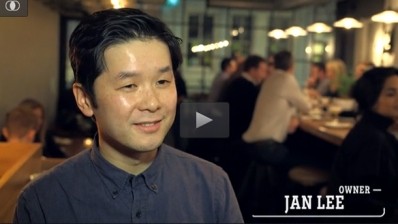Korean food: is it ready to go mainstream?
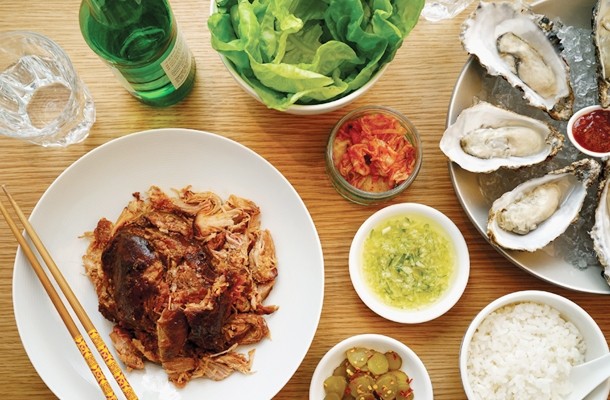
It may come as a surprise to some that England has a Korean restaurant guide. Last published in 2012, the admittedly svelte volume lists 41 establishments, the vast majority in central and greater London with a particular concentration in New Malden, south-west London, which is home to the biggest Korean expatriate population in Europe.
Korean food has had a presence on these shores since the 1970s but has yet to break into the mainstream. Most people in the UK have yet to discover the charms of bibimbap, a highly customisable rice dish, and bo ssam, a DIY sharing dish involving slow-cooked pork wrapped in lettuce leaves.
In fact, according to Korean-American chef Judy Joo, many British people aren’t even entirely clear of the country’s geographical position. “Don’t ask me why but people often think Korea is in south-east Asia and not between China and Japan. It’s not a tropical country. You won’t find coconut milk or kaffir limes in our cooking.”
New Jersey-born Joo is one of the few exponents of Korean food in the UK. A celebrity chef of sorts – she’s been a judge on both the US and UK incarnations of Iron Chef and hosts a number of US-made Korean food shows – Joo studied at the International Culinary Center in New York and has cooked in some high-profile restaurants in London and the States.
Following a stint as executive chef at The Playboy Club, she has just opened her first Korean restaurant on Soho’s Kingly Street. Jinjuu is positioned as a casually hip restaurant that serves relatively authentic Korean dishes alongside plates that play with Joo’s diverse culinary experience, and her US upbringing.
“Cooking for me has always been about a melding of cultures. I’m Korean-American but my training is French and I’ve worked in the US and the UK,” says Joo. “Ethnic food is always evolving. The Chinese food you get in London is not like the food in China, just as in the US Italian food is – in the main – very different to anything you’d find in Italy. I think this is a good thing. Borders are becoming more fuzzy. People are more global now.”
A view from America
Joo spent the majority of her life in the US where Korean food has a much bigger presence due to large Korean enclaves in and around some major cities, including Los Angeles and New York.
“Over here we have New Malden, of course, but this is not really comparable with the K-Towns of LA and New York, which are more centrally located and cater to a mixture of Koreans and non-Koreans. In New Malden most of the restaurants serve a predominantly Korean customer base and almost all of them are mom and pop-style joints that serve large, traditional menus of old-school Korean food.”
The restaurant’s signature ‘KFC’ dish (Korean Fried Chicken) serves as a good illustration of Joo’s culinary approach. Fried chicken, as Westerners know it, is not a traditional dish in Korea, but dakgangjeong – a fried chicken dish that results in a sticky rather than crunchy chilli-heavy coating – is extremely popular.
Prepared in a pressure cooker for more succulent meat, Joo’s version fuses the two approaches. The chicken is coated with a batter containing matzo meal – a nod to Joo’s time in New York – and an eclectic mix of spices including gochugaru (Korean chilli flakes). The dish is served with two dips: a red sauce based on gochujang (fermented chilli paste) and an umami-packed black sauce made with Jinjuu’s own soy sauce.
As is often the approach in Korean restaurants in the US, Joo’s menu is divided into contemporary and traditional. Contemporary options include a Korean take on moules mariniere involving white wine, bacon and gochujang as well as sae-woo pops – fried prawn cakes on sticks served with gochujang-spiked mayonnaise. Traditional dishes include yook-hwe (Korean-style steak tartare) and mandoo meat dumplings but, Joo points out, they’re not intended to be exact replicas of the dishes found on the streets of Seoul and Busan.
“I like to tweak things a little and add my own finishing touches, but they certainly would resemble what people eat in Korea. My plating is perhaps more polished, I don’t use MSG, which is standard in Korea, and I pay a lot of attention to provenance,” she says.
New identity
Although it’s still easy to find traditional Korean restaurants with large menus in the US, the past five years or so has seen the image of Korean food change dramatically. What was once an ethnic novelty of varying quality has become an integral part of the New American Cuisine as Korean-American chefs look to forge a new identity for their homeland’s cooking.
The most high profile of these is David Chang, the acclaimed chef behind international restaurant brand Momofuku. He has brought several Korean foods into the American restaurant vernacular, including the aforementioned bo ssam. Chang – who holds two Michelin stars at his Momofuku Ko restaurant in New York – specialises in unpretentious, high-impact Asian food that relies heavily on Korean ingredients and cooking process.
However, the Virginia-born chef’s restaurants can’t really be described as Korean. This is a common thread. This new wave of Korean food is more about fusion than the promotion and preservation of traditional Korean dishes. Roy Choi – an LA-based Korean-American – has become one of the most trendy chefs in the States off the back of a ‘Korexican’ food truck, which knocks out dishes that combine Korean and Mexican dishes and ingredients. Classically trained, he is perhaps best known for his tacos, which are filled with Korean-style barbecued meat and garnished with a mixture of Mexican and Korean ingredients and condiments.
Korean-Mexican food is already starting to take off within London’s street food scene, and a new restaurant in Soho is also at least partly flying the Korexican flag. Billed as an east Asian barbecue joint, Bo’ Drake is the creation of Jan Lee, who grew up in Berwick-upon-Tweed where his family ran a string of Chinese restaurants. His wife Jae is Korean and the time the couple spent in the country has had a big impact on the menu.
“We describe the restaurant concept as east Asian barbecue, but it’s more than that because we have Heath [McDonald, head chef] in the kitchen and he has a lot of experience with Mexican food. It’s a very cross-cultural approach and we want to create something that’s genuinely new.”
The restaurant’s kimchi – which has already received the thumbs-up from long-standing Evening Standard critic Fay Maschler – is made according to Lee’s mother-in-law’s recipe but a little extra sugar is added and it’s only fermented for two weeks. “In Korea it would be fermented for longer but we want it to be palatable for those that might be less familiar with Korean food. It’s still got a deep, funky flavour though.”
Bo’ Drake’s recipe for bo ssam is influenced heavily by US barbecue cookery. Apparently Pitt Cue Co, an influential and highly creative barbecue restaurant just down the road, has been a big inspiration. Rather than being boiled, as is traditional in Korea, the pork is smoked low and slow for 12 hours and then pulled. “We use the neck end of the collarbone as it’s got just the right amount of fat,” says Lee.
Moving the food even further into fusion territory are Bo’ Drake’s kimchi quesadillas with Mexican cheese and a cream made from poblano chillies. Many traditional Korean restaurants in the UK revolve around meats grilled over solid fuel and this is even more common in the US, with a number of big Korean barbecue chains currently on the expansion trail. Lee believes that with Korean food already associated with barbecue, the average restaurant-goer will find it relatively easy to get their heads around this fusion between Asian and American cooking.
Fusion food
Bo’ Drake doesn’t profess to being a Korean restaurant and won’t be expecting a listing within the next edition of the Korean Restaurant Guide’s England edition. One restaurant outfit that might, however, is Bibigo.
The 100 or so-strong international group – a subdivision of Korean food giant CJ Foods – opened its first UK restaurant on Soho’s Great Marlborough Street in 2012 and has just opened a second in Islington, moments from Angel Tube station. While the interior is modern and fresh, the offering feels staunchly traditional when compared with the likes of Jinjuu. There are pictures of every dish on the menu, which majors on the greatest hits of the cuisine without a hint of fusion.
“Korean food is being talked about a lot but most of the people serving it are picking elements and combining them with other cuisines,” says Hy Park, who heads Bibigo’s expansion in Europe. “The intention at Bibigo is that it’s quite similar to what you’d get in Korea, although we have made a few adjustments to suit the UK palate. Eventually the customer will want to taste the genuine article as their understanding of the cuisine grows.”
He does have a point. While fusion cooking has a much better image than it did a decade ago, many Chinese, Indian and Japanese restaurants owe their success to staying true to the source material. A more regional, studied approach to ethnic cuisine is certainly in vogue in more upmarket ethnic restaurants and it could be argued that playing with a cuisine that’s yet to be fully understood by the wider dining public may cause confusion.
Park – who hopes to open four more Bibigos in London before turning his attention to other major UK cities – believes that the intrinsically healthy nature of Korean food will boost his group’s expansion prospects. “Korean food is balanced. We eat a lot of meat but it’s always partnered with vegetables, and the health benefits of kimchi are well-known,” he says.
With a boom in healthy restaurant concepts it’s difficult to argue with this sentiment. However, a nutritiously virtuous approach doesn’t seem to have helped Kimchee, a fast-casual format intended as a Korean answer to Pret A Manger. Created by Dong Hyun Kim – the Korean behind successful sushi takeaway chain Wasabi – Kimchee launched in mid-2013 and reworked office lunch staples to produce a menu with an array of healthy options including kimbap, a Korean take on sushi.
Originally Hyun Kim hoped to have 15 branches trading by now but just two have opened, suggesting that Kimchee has not been as well-received as first hoped. That said, the company is looking to open a third site soon the fast-casual concept’s bigger full-service brother in Holborn is one of the most successful Korean restaurants in London.
Fresh allure
It’s not hard to see why commentators have been predicting a boom in Korean food. On paper its prospects look strong. It is healthy, supremely adaptable and ties into a number of other restaurant trends, including barbecue and sharing. But, perhaps most importantly, it has the allure of something that’s genuinely new while still sharing similarities with cuisines already well-established in the UK, most notably Chinese and Japanese.
The possibility of Korean food replicating the success of these cuisines, as well as Indian and Thai, is undeniably exciting but seems unlikely to happen any time soon. UK-based Korean chefs aren’t exactly queuing up to rework their cooking for the British market as has been the case in the US, and there appears to be only a handful of people on these shores looking to promote it. And with most diners still largely unfamiliar with the country’s food, it seems the editors of a certain Korean restaurant guide may have to wait a while until they can pull together a decent number of new entries.
This article first appeared in the March edition of Restaurant magazine. Subscribe here or view the digital edition here.
